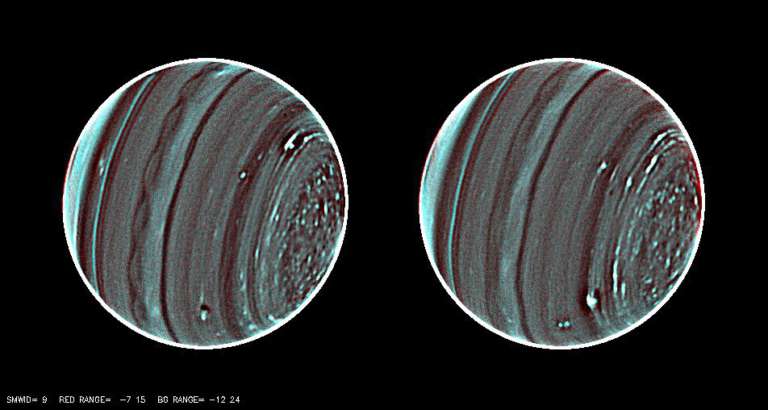Björn Jónsson • Dec 10, 2014
Revisiting Uranus with Voyager 2
When the Voyager 2 spacecraft flew by Uranus back in January 1986, it saw an almost featureless planet. This was a disappointment after the spectacular images Voyager 1 and 2 obtained of Jupiter and Saturn. The only visible features on Uranus were very low-contrast cloud bands and a handful of very low-contrast, discrete cloud features. They were only clearly visible when image processing was used to greatly exaggerate the contrast of the Voyager 2 images.
In the years since the Voyager 2 flyby, Earth-based telescopes have been able to observe Uranus with steadily increasing clarity, thanks to both an increase in Uranus' atmospheric activity and better instruments (in particular, adaptive optics). A very important advantage over Voyager 2 is that these telescopes/instruments can observe Uranus in near-infrared light where Uranus' atmospheric features are more clearly visible. Voyager 2's problem was that it couldn't image Uranus at near-infrared wavelengths. The longest wavelength of light it could "see" was orange.
By far the most amazing Earth based images obtained of Uranus are the images described in this blog entry from 2012. I felt as if I was looking at a completely new planet when I saw these images. They are the result of sophisticated processing where a lot of images have been stacked and derotated to decrease noise and compensate for Uranus' rotation and east-west zonal winds over the long time required to obtain the images.

A few months ago I started wondering what would happen if comparable processing was applied to the Voyager 2 images of Uranus. I posted early results of this work at Unmanned Spaceflight in September.
I have now processed a different set of Voyager 2 images more carefully. For best results, I wanted images obtained in orange and green light, as these generally show more details than the blue and violet images. I searched for images where Uranus was as big as possible without parts of it getting clipped off at the image edges, and found a nice 20-image sequence obtained over a period of 10 hours on January 16-17, 1986 when Voyager 2 was about 10 million km from Uranus. I then used SPICE kernels from NASA's Planetary Data System to determine the viewing geometry of these images, made necessary corrections to the camera pointing (the SPICE kernels have inaccurate pointing), and reprojected the images to simple cylindrical projection. This processing step corrects for Uranus' rotation among other things. When doing this I also removed the effects of different illumination across different parts of Uranus' disc. A typical cylindrical map looks like this:
But it is necessary to also correct for Uranus' powerful east-west zonal winds. This schematic image shows the approximate movement caused by these winds over 5 hours if this is not corrected (the images I was using were obtained over a period of 10 hours):
To correct this I used the most up date date version of Uranus's zonal (east-west) wind profile that I could find to determine the amount by which to shift individual image lines in the cylindrical maps to the east or west. I then stacked the 20 corrected ("derotated") cylindrical maps, rendered an image and greatly enhanced the contrast. I made two versions that reveal significantly more details than the original images did. In the first version, only a contrast stretch has been applied.

This reveals a lot of details while preserving large scale brightness variations, for example the polar areas are brighter than areas closer to the equator. The strange appearance of Uranus' limb is a processing artifact. In the second version a combination of high pass filtering and contrast stretch has been used.
Some of the small scale details are now more obvious but the large scale brightness variations have been suppressed so in a sense this version is slightly less realistic. Many details are clearly revealed in these images that are either not visible in the original images or look very subtle, even after a severe contrast stretch and filtering.

In this image some of the details I'm sure are real are indicated with green arrows.
I'll end this by mentioning that recently, far more sophisticated processing of the Voyager 2 images than has been described here has revealed a huge number of cloud features on Uranus. A lot of images (1600!) was used, see e.g. http://uanews.org/story/clues-revealed-about-hidden-interior-of-uranus. This revealed lots of details and Uranus now looks more interesting than ever.
Let’s Go Beyond The Horizon
Every success in space exploration is the result of the community of space enthusiasts, like you, who believe it is important. You can help usher in the next great era of space exploration with your gift today.
Donate Today

 Explore Worlds
Explore Worlds Find Life
Find Life Defend Earth
Defend Earth




